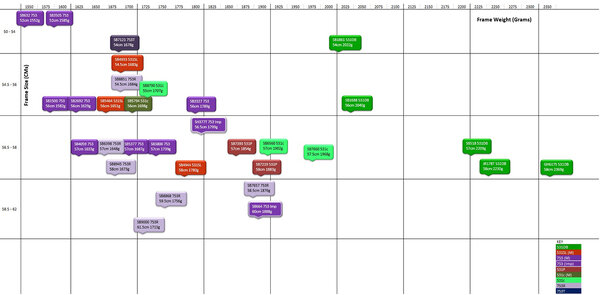originalshinkicker
rBotM Winner
If you said it was a 70s frame then it won't be 531c or 531P as they came out in 1982. I'm not aware that 531P included any 753 tubes (that was 653 which was a mixed strength tubeset). The SBDU for example sold a lot of 531P chromed frames in 84/85 and the SBDU would never chrome 753.
What are the diameters of the tubes... is it Metric or Imperial as some Metric frames can be much lighter than their Imperial counterparts.
Metric = 26.0 TT 28.0 ST & DT
Imperial = 25.4 TT 28.6 ST & DT
What is the seat pin size?
Most fork weights are the same between tubesets and only differ in weight because of the use of different crowns and length of steerer (some forks also have a lighter plain gauge steerer opposed to a single butted steerer) - fork blades themselves tend to be the same gauge and therefore similar weights. I rarely weigh forks now, a bigger frame has a heavier fork, a smaller frame has a lighter fork.
As well as different outer diameters, you also have to consider that most tubesets had several different gauges available - they weren't all the same tubes, this offered builders options on building lighter/stiffer frames while still using the same tubeset. For example, I have a 52cm 753 frame which weighs in at 1585g but I also have a 56cm 753 frame built from the same Metric 753 tube and although it is 4cm larger and also longer, it is the same weight 1582g so that means there must be something going on internally with tube gauge even though both frames have the same frame transfer and are derived from the same overall set.
Check things like a short top tube... shorter tubes make lighter frames, a shorter top tube, shorter down tube and shorter chain stays mean less metal.
Trying to pinpoint tube type based on frame weight and seat tube length is tough. Here is an image of a few of my SBDU frames and their weights (frame only), you can see that weights are all over the place...
If you look at the region of approx 1700g I have frame sizes from 54 to 61 cm in 5 different tube types...
You also have a Columbus steerer so you can't rule out Columbus tubing
What are the diameters of the tubes... is it Metric or Imperial as some Metric frames can be much lighter than their Imperial counterparts.
Metric = 26.0 TT 28.0 ST & DT
Imperial = 25.4 TT 28.6 ST & DT
What is the seat pin size?
Most fork weights are the same between tubesets and only differ in weight because of the use of different crowns and length of steerer (some forks also have a lighter plain gauge steerer opposed to a single butted steerer) - fork blades themselves tend to be the same gauge and therefore similar weights. I rarely weigh forks now, a bigger frame has a heavier fork, a smaller frame has a lighter fork.
As well as different outer diameters, you also have to consider that most tubesets had several different gauges available - they weren't all the same tubes, this offered builders options on building lighter/stiffer frames while still using the same tubeset. For example, I have a 52cm 753 frame which weighs in at 1585g but I also have a 56cm 753 frame built from the same Metric 753 tube and although it is 4cm larger and also longer, it is the same weight 1582g so that means there must be something going on internally with tube gauge even though both frames have the same frame transfer and are derived from the same overall set.
Check things like a short top tube... shorter tubes make lighter frames, a shorter top tube, shorter down tube and shorter chain stays mean less metal.
Trying to pinpoint tube type based on frame weight and seat tube length is tough. Here is an image of a few of my SBDU frames and their weights (frame only), you can see that weights are all over the place...
If you look at the region of approx 1700g I have frame sizes from 54 to 61 cm in 5 different tube types...
You also have a Columbus steerer so you can't rule out Columbus tubing
